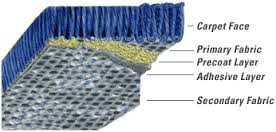While this rarely happens, occasionally after cleaning you may start to see large waves and ripples . This can be disconcerting to see after having your carpets cleaned but it is not only normal but temporary.
This is referred to as latex displacement, which is technically called the expanding differentials. Several things can lead to latex displacement and most of them are directly with the carpet construction.
Carpet is comprised of several layers. These include :
1- The face yarns (the carpet fibers you walk on)
2- The primary backing
3- The secondary backing
4: Latex adhesives, which bond the the primary backing, secondary backing, and the face yarns

Photo courtesy of Dow.com
Most manufacturers use a type of clay primarily made of marble dust. This gives the latex bulk and allows it to spread. This clay also absorbs water more easily which will cause it to expand. In the right conditions, which may include water in the carpet from cleaning, household floods, river or oceanfront proximity or if the humidity is high on a particular day, this expansion will become readily noticeable. The result to carpeting will be wrinkles or buckling. Depending on the type and amount of clay in the latex, these buckles can actually become waves.
The clay will return to its normal state as the adhesive dries, and the carpet will lay flat again.
On a side note, when the clay adhesives are wet, the glue is weakened, but after drying out, they become structurally more sound than before getting wet!
Displacement can be affected by the carpet type and make. Not all fibers have equal water absorption. Wool fibers can retain almost 100% of their weight in water, with Nylon holding up to about 20%, and other synthetics such as polyester and polypropylene fibers holding much less. Therefore, you should expect Nylon and wool carpets to take longer to dry. They are also far more likely to have water get into the backing and clay adhesive of the carpet. Berber style and looped carpets may also take longer to dry since water doesn’t wick as easily.
Carpets do not always return to its original state or wrinkles start to appear randomly. The usual cause being improper installation. Manufacturer guidelines indicate carpets need to be power stretched into place, and then be properly tacked down. The use a knee kicker is required for proper placement onto a tack strip in order to hold the carpet in place.
Carpet which is not properly stretched will go back to its original or un-stretched state. This creates wrinkling in the carpet. Some areas of the carpet may be attached to the tack strips while others aren’t.
Carpet age also plays a factor. If the backings are starting to fail or if the glue is starting to break down, carpet stability will be decreased, causing the carpet to start buckling. This may result in the delamination of the carpet, where the primary and secondary backings start to separate.
Other common causes of delamination are the improper use of solvents or spot removers, over-saturation from pet accidents and the use of office chairs with wheels (placing a mat or rug underneath will help).
The most unlikely cause of buckling is manufacturer defect. Improperly mixed glue, spreading issues if the carpet is not cured properly may also cause wrinkles to occur. Properly maintained carpets may be covered under your manufacturer’s warranty. Please refer to the manufacturer for more information.